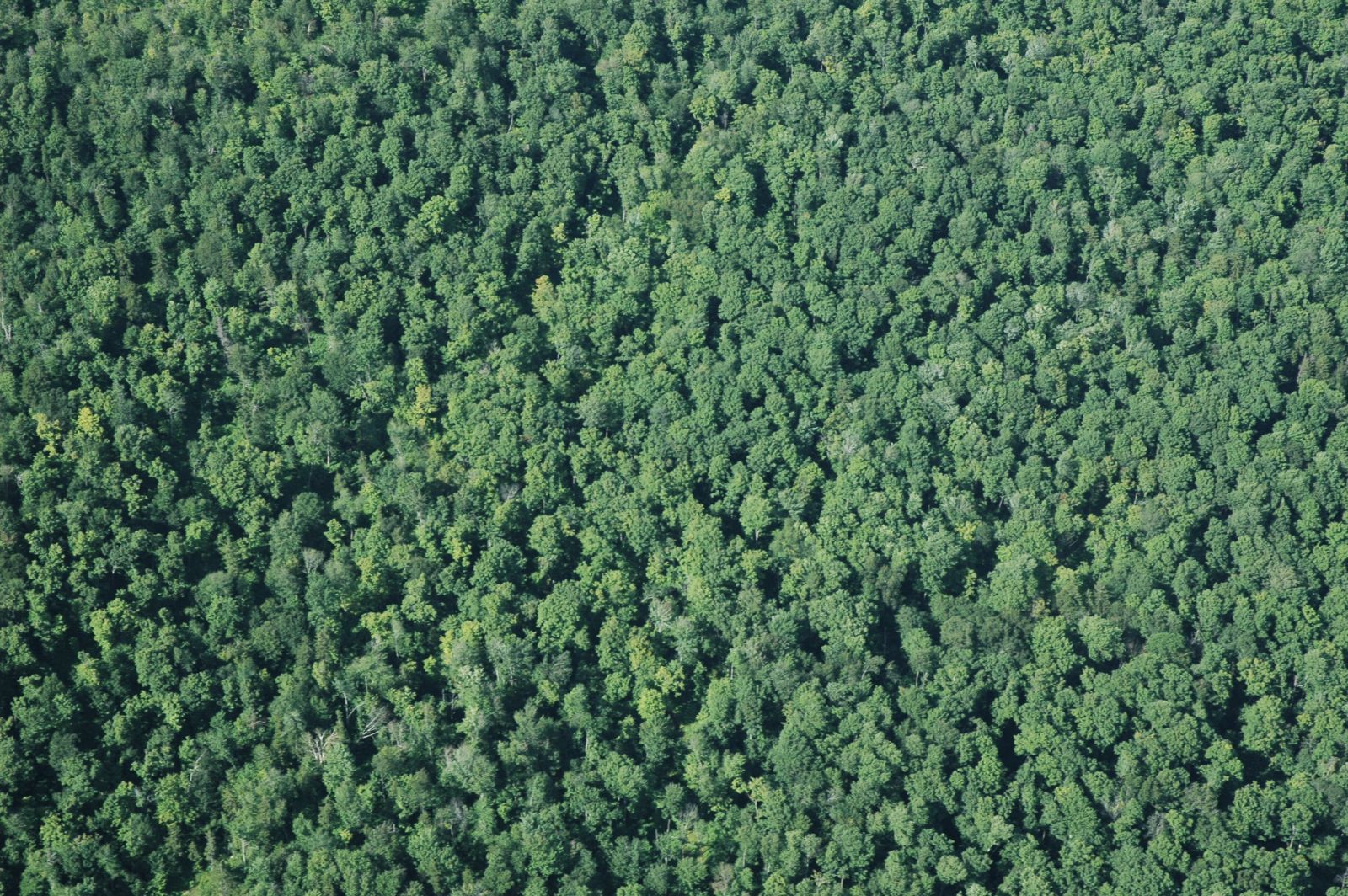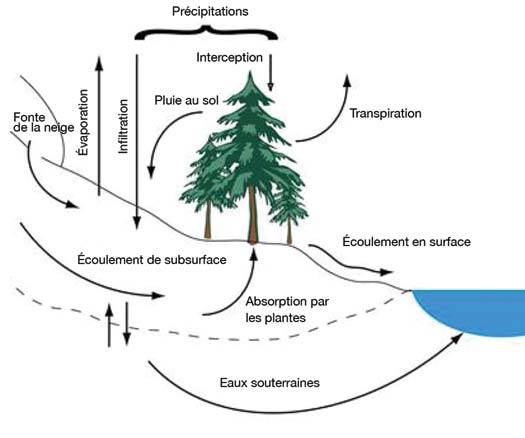Forests
Context Before the beginning of the nineteenth century, the Lake Memphremagog watershed was almost completely covered in forests. The establishment of farming, and, more recently, the rapid residential development of rural areas, with its associated road and housing construction boom, have eaten away at this forest cover. What forests remain are primarily privately held. The ecosystem needs this forest cover, and once it disappears, the equilibrium of the entire lake’s ecosystem is threatened. As well, the advent of climate change leads us to wonder what the effect of these increased pressures will be on the hydrological network of the watershed. Do we want to attempt to re-establish this equilibrium? The health of the lake is indisputably tied to the preservation of the forest cover, and, at least in part, to the re-establishment of the forest cover that has been lost.
Before the beginning of the nineteenth century, the Lake Memphremagog watershed was almost completely covered in forests. The establishment of farming, and, more recently, the rapid residential development of rural areas, with its associated road and housing construction boom, have eaten away at this forest cover. What forests remain are primarily privately held. The ecosystem needs this forest cover, and once it disappears, the equilibrium of the entire lake’s ecosystem is threatened. As well, the advent of climate change leads us to wonder what the effect of these increased pressures will be on the hydrological network of the watershed. Do we want to attempt to re-establish this equilibrium? The health of the lake is indisputably tied to the preservation of the forest cover, and, at least in part, to the re-establishment of the forest cover that has been lost.
What, exactly, is the forest cover?
The forest cover is simply the vegetation that covers the land naturally, when it is unoccupied, and we do not carry out anthropic activities on it. It is the best possible regulator of the hydrology of the watershed. It is also the habitat of many species of flora and fauna, including a number of vulnerable and threatened species. As well, it regulates the cycle of nutrients and trace elements (nitrogen, phosphorus, potassium, sulfur, etc.) and is a phenomenal carbon sink. In one study of the lakes of the Eastern Townships, professor Yves Prairie of GRIL (Groupe de Recherche en Limnologie) concluded that the most harmful factor, and that contributes the most to phosphorus loading in the lake is deforestation. Forest cover is at the core of tourist activity such as ecotourism, which encourages green activities that have minimal impact on the environment, which continues to attract a growing clientele.
What is the hydrology of a watershed?
During snowmelt and rainfall, waterways experience increased water flow. These variations in water flow are influenced by the quantity of snow on the ground when it melts as well as by the intensity and extent of rainfall. However, retention of water in the soil by vegetation and evapotranspiration also affect water flow.

How does the forest cover regulate the hydrology of a watershed?
Water capture and evapotranspiration by vegetation
Forest cover promotes evapotranspiration over trickling on the surface, which allows water to rapidly reach waterways. In fact, plants need vast quantities of water for their metabolism. They capture a portion of rainfall before it reaches the ground and allow it to evaporate back into the atmosphere via transpiration. In its natural state, a forest captures 25% of the rainfall; the rest soaks into the soil rather than flowing across the surface. Thus, the forest cover acts as a buffer during intense rainfall. Note that experts predict an increase in intense rainfall in coming years.
Infiltration of water into the soil
By its porous nature, forest soil allows the water that soaks into it to recharge aquifers, rather than flowing into nearby waterways. Water flows across the surface much faster than it does once it soaks into the soil.
Protection against the impact of raindrops
Vegetative cover is the best way of protecting soil from the breakup of soil particles and their transport to the nearest waterway (erosion) via the action of raindrops.).
What benefits does forest cover provide as a hydrologic regulator?
Reduction of surface erosion
Water that flows across the surface rather than soaking into the soil causes erosion.
Reduction of the transport of pollutants towards aquatic ecosystems
Water that flows across the surface of the soil to the nearest waterway uses ditches and storm drains or flows across asphalt, concrete, lawns and roofs. In so doing, it carries with it sediments and pollutants that are to be found in these areas. During downpours, the water reaching streams and rivers is particularly charged with sediments and pollutants due to the erosion on urbanized terrain. These sediments carry with them phosphorus, the principal cause of the presence of cyanobacteria in our waterways. As a consequence, the lake receives more soil particles, silting up more rapidly, causing accelerated eutrophication.
Flood reduction
As a result of water capture, evapotranspiration and soaking into the soil, water flow towards waterways is greatly reduced. This results in reduced maximum water flows, both in quantity and speed, and their spread over a longer time frame. This results in a buffering of water flows, reducing the occurrence of sudden and intense flooding.
Lower risk of flooding
If the forest cover is altered, floods can occur in areas where they never occurred before.
Maintenance of the structure of waterways
When water flows and their speed increase, the shorelines of waterways come under increased pressure. This causes all kinds of alterations, such as shoreline erosion, increased size of the waterway, sedimentation, etc.
Maintenance of the integrity of water infrastructure
Increased water flows can result in the need to rebuild bridges and culverts that were not designed to handle water volumes above a certain level.
Maintenance of the sustainability of small waterways during low water periods
By promoting the infiltration of water into the soil, the forest cover allows aquifers to recharge, thus providing water to small water courses even during extended dry periods. Small waterways are thus assured of permanent, non-intermittent water flow, allowing them to fully carry out their role as habitat.
What are the threats to our forest cover?
Forest areas are under pressure from a variety of sources, as they are coveted for many different uses, such as residential development, resort development, recreational uses and lumber extraction. It is important to manage these activities in a respectful way, so as to maintain a healthy ecosystem. We must remember that use of forest areas for lumber extraction, hunting, hiking and for the beauty of their landscapes is intimately tied to the economic development of local communities. These communities can diversify their sources of revenue by a sustainable use of their resources, as well as contributing to the quality of life of their residents. Uncontrolled residential development is the principal threat to the forest cover. The alteration of the forest cover is often the result the urbanization of the territory, with its attendant increase of hard, impermeable surfaces. The construction of parking lots, paved streets, houses, public and commercial buildings exacerbates the problems caused by the alteration of the forest cover. Intense deforestation caused by irresponsible forestry practices is also a threat to the forest cover, especially in areas with a slope greater than 15%.
Forest cover: an irreplaceable habitat
Forest cover ensures an adequate habitat for indigenous flora and fauna, as well as the interactions between them. The region’s forests are of great ecological richness. A large number of species, including a number that are threatened or endangered, depend in part or in total on the forest areas of the region. For example, 90% of North America’s threatened birds depend on forest habitat, and 12% of the threatened and endangered flora of Québec are found in forests. As well, certain mammals require large undisturbed territories for their survival. This is the case for the bobcat, the eastern cougar and the wolf. The construction of roads and houses creates barriers to the free movement of these species. Local populations find themselves isolated, unable to maintain genetic diversity. In the long term, the reduction of connectivity between these natural habitats compromises the survival of all of the region’s populations, since most species depend on proper genetic mixing to remain viable. Forested areas are also preferred hunting areas.
Forest cover: a phenomenal carbon sink
All of the organic matter in a forest is an immense carbon reservoir, especially the wood of trees and the organics in the soil. It is our best defense against global warming. This is a serious consideration in the context of the climatic changes that we are experiencing.
What are the forests that absolutely require our attention?
There are still a number of large unbroken forested areas in the Lake Memphremagog watershed, as well as some quite exceptional forest ecosystems, as defined by the Ministry of Natural Resources and Wildlife (MRNF). Among them are some rare forests, forests harboring species atrisk, vulnerable or threatened as well as some ancient forest stands. In fact, there are 67 privately held exceptional forest ecosystems in the Eastern Townships. More than half of them (42) harbor vulnerable or threatened species of flora, 17 are rare ecosystems and 8 are ancient forests. These forests cover an area of 2,161 hectares. It is essential that these areas be accorded specific protection in MRC and municipal management plans.
Ancient forests
An ancient forest is a forest ecosystem where the dominant trees have reached or passed their mature stage. These forests have a particular dynamic. We can recognize them by their old and dead trees of varying sizes, as well as the variety of rotting trunks found on the ground. From all appearances, they have been little affected by human activity over the last decades.
Rare forest ecosystems
Rare forest ecosystems are defined by a specific mix of species, their unique structure or their location. They are considered rare because they have a specific mix of ecological conditions, or because most of them have disappeared due to human actions.
Shelter forests
Shelter forests are characterized by the presence of one or more vulnerable or threatened species of flora, for example by the presence of an exceptional population of one or more of these species. A threatened species is defined as a species whose disappearance is likely, and a vulnerable species is one whose status is precarious, even if it is not in immediate danger of disappearing.
Fore more information:
Les défis de la forêt privée: La conservation, l'utilisation durable de la forêt et l'écotourisme
Agence de mise en valeur de la forêt privée de l'Estrie, 2008. Plan de protection et de mise en valeur.
Agence forestière des Cantons de l'Est, 2009. L’arbre et la forêt – Page Internet
Association forestière des Cantons de l'Est (AFCE), 2009. Portail officiel - Site Internet
Agence de mise en valeur de la forêt privée de l'Estrie (AMFE), 2009. Portail officiel - Site Internet
Regroupement des sociétés d’aménagement forestier du Québec (RESAM). Portail officiel - Site Internet
MRNF Estrie, 1999. Guide ressource sur le milieu forestier - Document
AMVFPE, 2002. Plan de protection et de mise en valeur de la forêt privée de l'Estrie – Document
AFCE, 2007. Localisation des Écosystèmes Forestiers Exceptionnels en Estrie - Carte
Le Progrès forestier, 2006. Les Écosystèmes Forestiers Exceptionnels - Article

